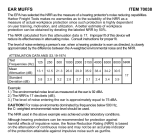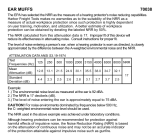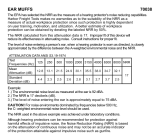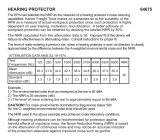Page is loading ...

EAR MUFFS
The EPA has selected the NRR as the measure of a hearing protector’s noise reducing capabilities.
Harbor Freight Tools makes no warranties as to the suitability of the NRR as a measure of actual
workplace protection since such protection is highly dependent on user training, motivation, and
utilization. A better estimate of workplace protection can be obtained by derating the labeled
NRR by 50%.
The NRR calculated from this attenuation data is 23. Improper fit of this device will reduce its
effectiveness in attenuating noise. Consult instructions for proper fit.
The level of noise entering a person’s ear, when a hearing protector is worn as directed, is closely
approximated by the difference between the A-weighted environmental noise and the NRR.
ATTENUATION DATA ANSI S3.19-1974
Test
Frequencies (Hz)
125 250 500 1000 2000 3150 4000 6300 8000 NRR
Mean
Attenuation (dB)
15.3 19.0 27.5 38.1 36.1 37.4 34.5 35.5 34.8
23
Standard
Deviation (dB)
3.0 2.4 2.2 3.2 3.0 2.6 2.8 3.0 2.9
Example:
1.) The environmental noise level as measured at the ear is 92 dBA.
2.) The NRR is 23 decibels (dB).
3.) The level of noise entering the ear is approximately equal to 69 dBA.
CAUTION! For noise environments dominated by frequencies below 500 Hz, the C- weighted
environmental noise level should be used.
The NRR used in the above example was achieved under laboratory conditions.
Although hearing protectors can be recommended for protection against harmful effects of
impulsive noise, the Noise Reduction Rating (NRR) is based on the attenuation of continuous
noise and may not be an accurate indicator of the protection attainable against impulsive noise
such as gunfire.

Wear Instructions
1. Adjust the band to the proper position.
2. Pull hair out of the way and out from beneath the muffs.
3. Adjust the height of the cups so they fully enclose the
ears and the cushions press equally around the ear.
4. It is important that cushions seal
completely around the ear.
5. Always wear ANSI-approved safety glasses
when working with tools and equipment. When
using these ear muffs with safety glasses, the
safety glasses must have thin temples that fit
closely around the head or thin straps, this will
help ensure a good fit and better protection.
1/2






